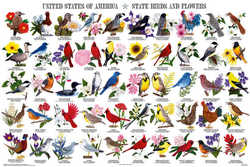Illinois State Bird
Northern Cardinal or "Redbird"

(Cardinalis cardinalis)
Adopted on June 4, 1929.
In 1928, the Macomb branch of the National Federation of Professional Women's Clubs urged that Illinois schoolchildren to select a State Bird. The idea was approved by the State Superintendent of Public Instruction, and schoolchildren chose the Cardinal, (Cardinalis cardinalis,) from a list of five birds conspicuous in Illinois. The General Assembly made that designation of the cardinal as the Illinois State Bird official on June 4, 1929.
The northern cardinal is also the state bird for six other states. These are Indiana, Illinois, Kentucky, North Carolina, Ohio, Virginia, and West Virginia.
Illinois State Bird: Cardinal

Cardinals, in the family Cardinalidae, are passerine birds found in North and South America. They are also known as cardinal-grosbeaks and cardinal-buntings. The South American cardinals in the genus Paroaria are placed in another family, the Thraupidae (previously placed in Emberizidae).
Characteristics of the Cardinal
Cardinals live in Illinois throughout the year, and have become quite abundant since 1900, when they were considered rare in the northern part of the state. The flash of red feathers of the male and the loud whistle of its song make it instantly recognizable.
Their distinctive color (scarlet for males, buffy brown and red for females), pronounced crest, heavy bill, and easily recognizable song make cardinals (Cardinalis cardinalis) some of the most readily identified birds in the state.
Today this bird is a common year-round resident throughout the state. This has not always been the case. Since about 1900 the cardinal has greatly increased in abundance in northern Illinois. Around the turn of the century it was considered a rare visitor to the Chicago area; now it is quite common in that area. Urbanization and the increased use of bird feeders may have allowed the cardinals to expand their range northward.
Cardinals build their nests in bushes. Their nests are usually about 1.5 meters (4 to 5 ft.) above the ground. The eggs are laid between the middle of April and the middle of August. Cardinals usually lay several clutches of eggs each season. Each clutch consists of between two and five whitish eggs with dark streaks and spots on them.
Cardinals usually feed on the ground or in low bushes. They eat a wide variety of insects, grains, wild fruits, and seeds. They are common birds around bird feeders.
Common Names
Redbird or Winter Redbird
History of the Cardinal Adoption

Illinois became the first of seven states to choose the cardinal as its state bird. The cardinal was made the official bird of Illinois in 1929 after receiving 39,226 votes. Schoolchildren selected this bird over the bluebird, meadowlark, quail and oriole.
The cardinal was named by early American settlers, after Catholic cardinals who dress in bright red robes. These birds are strongly territorial and have a loud, whistling song.
The Illinois Compiled Statutes
The law designating the Cardinal as the official Illinois state bird is from Section 10 (State bird) of the Illinois Compiled Statutes, Chapter
5 (GENERAL PROVISIONS) Section 460/10
GENERAL PROVISIONS
(5 ILCS 460/) State Designations Act.
(5 ILCS 460/1) (from Ch. 1, par. 2901-1)
Sec. 1. This Act may be cited as the State Designations Act.
(Source: P.A. 87-273.)
(5 ILCS 460/10) (from Ch. 1, par. 2901-10)
Sec. 10. State bird. The bird Cardinalis Cardinalis, commonly known as the "Cardinal", is designated the official State Bird of the State
of Illinois.
(Source: P.A. 87-273.)
Taxonomic Hierarchy: Cardinal
Kingdom: Animalia - animals
Phylum: Chordata - chordates
Subphylum: Vertebrata - vertebrates
Class: Aves - birds
Order: Passeriformes - perching birds
Family: Fringillidae - buntings, finches, grosbeaks, old world finches, sparrows
Genus: Cardinalis Bonaparte, 1838 - cardinals
Species: Cardinalis cardinalis (Linnaeus, 1758) - Cardenal rojo, northern cardinal








